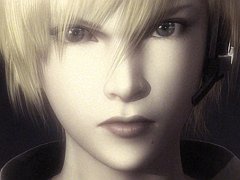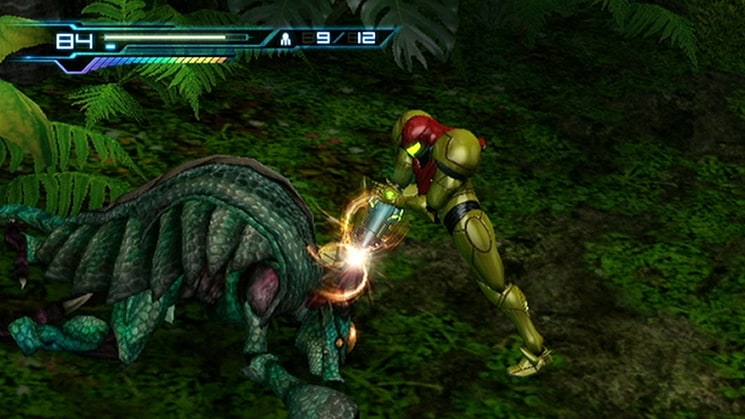You can trust VideoGamer. Our team of gaming experts spend hours testing and reviewing the latest games, to ensure you're reading the most comprehensive guide possible. Rest assured, all imagery and advice is unique and original. Check out how we test and review games here
Before we go hands-on with the Team Ninja-developed Metroid: Other M at Nintendo’s European Gamers Summit, held at Matter in London’s gargantuan O2 Arena, we’re shown the game’s GCI intro movie on a huge television. When it finishes, we are agog. We have just witnessed the greatest intro movie we’ve ever seen in a Nintendo game.
This is not to say that it is one of the greatest intro movies in all of gaming. It is to say that it’s great – by Nintendo’s standard. What this says about Nintendo is revealing: really, Nintendo has never “done” CGI. The Mario series focuses on pure platforming goodness. The Legend of Zelda series’ cutscenes use in-game assets. As for Metroid, well, the formative franchise has always been about platforming AND shooting – across multiple viewpoints – and little else.
This time, though, it’s about more. It’s a kind of gaming melting pot, a collaboration between Nintendo (Metroid co-creator Yoshio Sakamoto is involved) and Team Ninja that hopes to broaden Metroid’s appeal. Ingredients include the old school mechanics of Metroid, the third-person action of Team Ninja’s Ninja Gaiden, and the first-person shooting of Retro Studio’s Metroid Prime series. The result is a broth that’s unashamedly different, and one hell of an intriguing proposition.
Let’s jump back to just before we’re shown that intro movie. A lovely German Nintendo chap describes Other M as a “reboot” (isn’t everything a reboot these days?) and a “cinematic action game”. There’s loads of voice over dialogue and cutscenes, all edited to a breathless pace with constantly shifting camera angles; the intro movie is long (at least ten minutes); and there’s more of a focus on storytelling and backstory. Remember, for years Samus was a silent bounty hunter, a mysterious character who preferred to do her talking with a hand cannon. In other M, she won’t shut up.
Now, for that intro movie. Other M takes place after the events of Super Metroid, the much-loved 1994 SNES classic, but the intro movie recounts the game’s epic conclusion. We see Samus hanging in mid-air with her head stuck up Baby Metroid (yes, really, that’s how crazy the Metroid series is). Facing her is the towering, terrifying Mother Brain. Samus is defeated, but Baby Metroid recharges her in a final act of defiance. Mother Brain destroys Baby Metroid, but not before Samus falls to the ground. Then, gunarm charged with a new, devastating power, Samus destroys the end boss, the underground facility, and the planet of Zebes. Boom.
The recounting of this epic gaming moment in modern-day CGI sends shivers down our spine. It rekindles memories of a hazy summer spent playing Super Metroid on the SNES with nary a care for the outside world. It sends us scampering to YouTube to check out the boss fight in its original form. It’s as clear today as it was then: Super Metroid was 16-bit processor-fuelled 2D action par excellence. Even now, some 16 years later, Samus’ defeat of Mother Brain is hair-raising – disturbing, epic, and awesome in equal measure.
Now, it’s Team Ninja’s turn to carry the burning Metroid torch. Samus’ new adventure begins in a Galactic Federation ship. She has been reliving her recent memories in the form of nightmares – unsurprising, really, given how creepy those Metroids are. We hear her narrate from some unknown point in the future. She laments the loss of Baby Metroid, talks about the “power the baby gave me”, and says, no doubt with a look of concentrated self-awareness, “the finality of it struck me again”. Clearly, Samus has issues.
After a brief tutorial, we skip forward. Samus is travelling through space in her ship. She tells us that at that point the galaxy had begun to forget about Metroids and Space Pirates and all that she accomplished. But her peace is disrupted by an SOS. It is the “Baby’s Cry”. Samus immediately alters course and heads to its origin. “It was as if it was crying specifically for me,” she says in a monotone voice. She lands on a huge, apparently deserted “Bottle Ship”, the title sequence appears, and Metroid: Other M officially begins.
This is also the point where controversy begins. There appears to be a huge amount of disappointment – already – about Other M’s control scheme. The game is played with the Wii Remote only, held horizontally on its side as if a NES controller. The d-pad is used for movement, the A button turns Samus into a sphere, and the 1 and 2 buttons are used for jumping and firing. This seems perfectly fine, but it’s not until you actually play the game that you start to understand some of the concerns.
Other M is a 3D game viewed from a side-on perspective. Enemies appear all over the place – to your left, right, above and below you, and all that’s in between. To compensate for the fact that the Wii Remote’s d-pad only facilities eight directions, the game has an auto targeting system, which – in theory – makes destruction a simple case of pressing the d-pad in the general direction of an enemy and hammering the fire button. At first, this is enough to get the job done.
But when you go up against more than a few enemies, Other M starts to feel fiddly. The auto-targeting system doesn’t always target the enemy you want it to, so frustration can set in. The platforming is also a point of concern. When pixel-perfect platforming is required, you occasionally miss a jump or even jump on the wrong platform, because, again, you’ve only got eight directions to play with.
One of Other M’s hooks is being able to seamlessly switch from the standard view to a first-person view akin to the Prime series. To do it, you simply point the Wii Remote at the screen. In first-person mode, you can move the pointer around, target boss weakspots, solve puzzles, and shoot bog standard enemies, but your movement is limited. The camera will only pan a certain amount, and you can’t move Samus at all. Why can’t we use the Nunchuck thumb stick to move Samus? Why are we using old-school 2D controls in a 3D world? Why can’t we move while in first-person mode? All are valid questions.
But how does it feel to play? While you never feel as if you’re in complete control of shooting and platforming, exploration and combat feels remarkably fluid, fast, and responsive. Samus darts about like an armour-wearing cricket – just how she should, and there’s a handy Ninja Gaiden-style dodge move (press left or right on the d-pad just before an enemy attack hits) that helps get you out of trouble when enemies attempt melee attacks. The truth is that Other M’s controls aren’t half as bad as the naysayers would have you believe, but they’re not as good as they could have been. On the one hand, it would be great to play the game with a thumb stick, but not being able to do so doesn’t cripple it.
However, we are concerned with the first-person mode, a view point we’ll only use when the game forces us to. Take the first boss fight, for example. By this point we’ve sped through a few corridors, encountered a few dead ends that will no doubt open up after the collection of a power-up or two, and met up with a group of friendly soldiers (including some familiar faces). The battle is against a tentacle monster thing – the idea being to run about and dodge its tentacle attacks in the normal view, then, when the soldiers have frozen a part of it, switch to first-person mode, target the weakspot, and let off a missile. Moving the Wii Remote from side on to pointing forward is easy enough to do with your hand, but there’s a slight delay in-game as it switches perspective. And then, you’re rooted to the spot, leaving you prone to enemy attacks.
Nintendo’s goal is clear: it reckons a simple control scheme sans a thumb stick will broaden Metroid’s appeal. But we’ll stick with the traditional viewpoint as often as we can, thanks, enjoying the creepy sci-fi atmosphere, the Ninja Gaiden-style combat, the old-school Metroid exploration, and the exciting cutscenes, with as little frustration as possible.
Our excitement only slightly dampened, we leave Metroid: Other M intrigued. It is Nintendo’s answer to the hardcore critics: here is a classic Nintendo franchise being co-created by the developer of one of the most hardcore action game series of all time. And Team Ninja’s impact is clearly felt: the dramatic cutscenes and po-faced voice over, the darker tone, and the visceral third-person action, are evidence that the developer has been granted the freedom to stamp its authority on the influential Metroid formula. Will this melting pot of genres and mechanics – both old and new – result in a broth worthy of the Metroid name? Half an hour of gameplay, a boss fight and that intro movie, suggest it’ll be more haute cuisine than Betty’s Hotpot.
Metroid: Other M is due out in Europe in the third quarter of 2010.

/https://oimg.videogamer.com/images/ba43/metroid_other_m_14.jpg)
/https://oimg.videogamer.com/images/775f/metroid_other_m_13.jpg)
/https://oimg.videogamer.com/images/659e/metroid_other_m_11.jpg)






